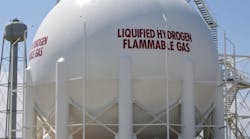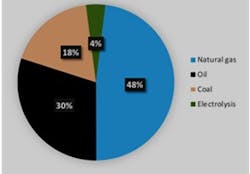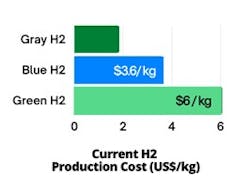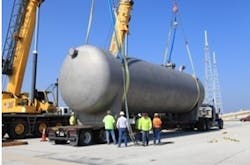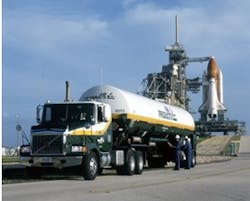Q: I saw your excellent article at ControlGlobal.com in January 2022, but I remain skeptical about storing large quantities of high-density (liquid or high-pressure gas) hydrogen, especially in aviation applications. How can this be accomplished?
Dr. Thomas Earle Moore, Ph.D, 3rd Rock Research
A1: In our transition to a carbon-free energy economy, hydrogen (H2) will play a key role. Therefore, large-scale and inexpensive hydrogen storage will be required. Today, yearly global hydrogen consumption is about 100 million tons. Most H2 is used in the ammonia (more than 50%) and refining (20%) industries. About 96% of all the hydrogen is made from fossil fuels, and only about 4% is produced by carbon-free electrolysis (Figure 1).
The different types of H2 are identified by colors:
• Grey hydrogen is produced by steam reforming of hydrocarbons. If made from coal, it’s referred to as "brown" or "black" for regular coal and "brown" for lignite sources. It’s the least expensive (about $2/kg) and is the source of about half of all hydrogen produced.
• Blue hydrogen is mostly made from natural gas. Some believe it’s cleaner than grey, but that’s debatable because the production and piping of natural gas results in large amounts of methane leakage.
• Turquoise hydrogen is a process that’s under development. It produces solid carbon and H2 by methane pyrolysis, eliminating the need to capture and store CO2.
• Green Hydrogen refers to zero-carbon H2, which can be further distinguished as "yellow" if made by green energy, and "pink or red" if made by a nuclear process. Both are produced by water electrolysis. In 2020, about 8 GW of electrolysis capacity was installed globally, and efficiency is expected to reach 82% to 86% by 2030.
Polymer electrolyte membrane (PEM) designs are comparatively simple and can accept widely varying voltage inputs, making them ideal for use with renewable energy sources. The International Renewable Energy Agency estimates the electricity required to produce a kilogram of high-pressure H2 is about 70 kWh (50 KWh for production and 15 to 20 KWh to increase pressure to 350 or 700 bar).
Large-scale storage and transportation
By the 22nd century, trucks and pipelines will probably be serving smaller users with H2 gas of up to 700 bar (up to about 1,000 kg per steel tube trailer). The transition will probably involve the gradual conversion of the present natural gas distribution pipelines to transport a mix of gas with H2. Large users will probably use H2 generated by immense solar power plants located in the tropics, which will simultaneously produce electricity, desalinify water and generate hydrogen. In temperate zones, wind or nuclear power plants could also be used, but nuclear safety must first be improved by moving reactors underwater, so they’ll be protected from cyber-attacks because their cooling water can’t be lost.
While converting to a zero-carbon age, an inexpensive H2 storage and distribution system must be developed. This requires green H2 to becomes less expensive than fossil fuels because we all "vote with our wallets."
To achieve this, it’s necessary to collect $50 per ton of emitted carbon from the emitters and use that money to finance the transition. This would create jobs and cost nothing to the non-emitting average voter. Unfortunately, this is a conflict of interest for the fossil fuel industry. Besides promoting the view that carbon emission doesn’t cause climate change, the fossil fuel industry came up with the idea of capturing the CO2 and pumping it underground—and it worked.
The Inflation Reduction Act includes a proposal that’s only profitable to fossil fuel corporations because it provides a $180 tax credit for every ton of carbon sequestered. This will further increase their profits as they must burn even more fossil fuels to generate the energy needed to push the carbon into underground caverns, plus they’ll squeeze the remaining 10% oil out of the abandoned wells. So, what do we get for those $180 tax credits? We get a fossil process that needs even more energy to run, can leak greenhouse gases, run out of cavern space, and leave us without any energy at the end. This is not a smart thing to do.
Our stone age ancestors were smart enough to switch to bronze, not because they were out of rocks, but because bronze was better. We should leave fossils where they are and switch to hydrogen because it’s better.
Cryogenic liquid storage
Liquid hydrogen is the signature fuel of the space program and the best fuel for launching satellites. NASA’s Artemis Moon landing program will have a 61-m (200-ft) tall and 8.4-m diameter disposable tank with a storage capacity of 537,000 gallons of liquid hydrogen kept at −253°C (−423°F). Thanks to NASA's extensive experience, the storage and transportation of hydrogen is safer than fossil fuels.
Liquid hydrogen is commonly transported in super-insulated, cryogenic tankers. Trucking liquid hydrogen with a density of 71 kg/m3 is more economical than trucking H2 as high-pressure gas (42 kg/m3 at 700 bar). A disadvantage of liquid transportation is boil-off. More than 1,000 kg of liquid hydrogen can be transported by a trailer and much more by ships or rail, provided railway lines or loading terminals are available. Japan has a liquid hydrogen storage site at a port in Kobe, while Kawasaki is building ships capable of storing 2,500 m3 volumes. Norway is designing a 9,000 m3 ship.
High-pressure gas storage and transport
Geological storage in salt caverns, saline aquifers, depleted natural gas or oil reservoirs, and in engineered hard rock reservoirs, are the least expensive options for large-scale and long-term hydrogen gas storage. It requires drilling down into a salt deposit to a depth of about 1,000 m and injecting water to dissolve and remove the salt, creating a large and tight cavern where high pressure gas (up to 200 bars) can be stored. About a third of the cavern volume is needed as a buffer gas to maintain cavern integrity, while the other two-thirds of the space is available for storage.
This technology isn’t new. A 200,000 m3 cavern at Teesside, U.K., has been in operation since 1972. Another in Clemens, Texas, with a volume of 580,000 m3, has been in operation since 1983. Newer caverns are under construction in Saxony-Anhalt, Germany, where wind energy will be stored as hydrogen. The world's largest (1,000 MW) cavern is being built by the Advanced Clean Energy Storage project in Utah. The average cavern has a diameter of 60 m and is 300 m high, and stores about 300 GWh of energy at 175 bar pressure. The EU is considering storage facilities that could even supply green energy for a whole winter or an entire year.
